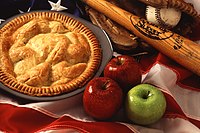Filipino-American cuisine
| Part of a series on |
| American cuisine |
|---|
 |
Filipino American cuisine has been present in America ever since Filipinos moved there, but only recently[when?] has the Filipino food become more widely popular.[1] Filipino food has gone through its evolution of adapting other cultures' food practices into their own, or borrowing the food concept into their own.[2]
Filipinos took their food and debut it as they came to America by presenting it in catering and opening up the Philippines' most popular food chain, Jollibee.[1] There is also a long list of different Filipino types of dishes that represent Filipino Americans.[3]
American influence
American influence on Filipino food is how some authentic meal was turned into frozen, ready-cooked meals.[4] This technique was used on Filipino dishes when Marigold Commodities Corporation teamed up with Ditta Meat Food Service Company to create these frozen Filipino meals.[4] They started in Austin, Texas, and released a few dishes that would incorporate the meat of America with Philippine flavors to create Filipino American food.[4]
Types of food
There were four of these Americanized Filipino dishes released into Texas under the work of Marigold Commodities and Ditta Meat Food Service.[4] Beef tapa uses Texas meat marinated with garlic, citrus flavors, and soy sauce, then grilled or fried.[4] The other dishes are tocino using chicken and pork meat, and pork longaniza.[4]
Restaurants
Catering
The Filipino restaurant trend of catering is continued in many restaurants such as Sunda in Chicago and Purple Yam in Brooklyn.[1] They have also continued to sell typical Filipino dishes in bulk such as lechon.[1]
Types of Filipino American dishes
A typical Filipino American dish consists of a soup, ulam (any food), kanin (rice), type of meat, fruits, and dipping sauces.[3]
Different soups may include things such as Munnggo gisado masabaw, a soup consisting of Mung beans and pork or shrimp. Another soup dish is pancit molo,[3] a Filipino style of the Chinese wonton soup. Meat dishes include adobo[3] made with pork or chicken; the dish is then cooked with vinegar, soy sauce, and garlic.[3]
Suman banana leaves containing sticky rice can be dipped in sugar to make it sweeter. Taho is a dessert that uses a syrup and boba inside of a jello-like soybean material.[3] There are numerous different Filipino dishes, and these are only a couple of them.[3]
Staples in Filipino food
Rice
Rice is a staple to Filipinos more than how cereal is known to be a basic breakfast food. Rice is used to help intensify some flavors,[2] or create other Filipino dishes like puto and bibingka. Puto can be meat-filled, ube-filled, or turned into cakes; it is made by making rice into flour.[2]
Rice is also created into a dessert called suman, a sweet rice wrapped in a leaf from a coconut or banana.[2]
Coconut
Coconut, like rice, is another staple in Filipino dishes; it is known as, buko, in the Philippine language and can be used in drinks, main dishes, or desserts.[2] There are dishes native to a specific region such as how in Quezon they make a dish using a leaf-wrapped shrimp, buko strips, and cook it in buko water.[2] Another region uses buko to mix it with chicken and ginger and cooking it inside of the buko; they also make a noodle dish where the noodles are made of coconut.[2] The white insides of the coconut are used to make milk, ginataan, and halo-halo, among others.[2]
Filipino American health
Food and health
A 2012 study across Asian American subgroups in Southern California (Chinese, Filipino, Korean, Japanese, and Vietnamese Americans) found that Filipino Americans self-reported the highest body mass indexes (BMIs).[5] This is because after the migration of Filipinos to the U.S. their diets changed and showed to have increase in energy-dense food, processed food, decrease in fruits, vegetables.[5]
This seems to have has a negative effect on the body leading to increase body weight and other health-related problems.[5] Specifically in Filipino American diets, there was an increase in milk, meat consumption, less starchy food and snacks.[5] This increase in eating by Filipinos has led to an increase in the calorie intake. This increase was almost doubled and along with it was a double in protein consumption and triple consumption of fat.[5]
United States and Canada
There was a study done in Canada on the average Filipino woman's health focusing mainly on the idea of body size, eating, and health.[6] Western culture has spread an idea that there is a concept of "healthy" and this concept in terms of woman would be that there is an association with being thin is attractive and vice versa for being fatter.[6] The study was then analyzed and what was found is that there was a risk of being "fat" associated with eating rice and an association of being thinner when watching[clarification needed] fat and rice.[6]
See also
References
- ^ a b c d Rodelas, Paola (Winter 2010). "Menu To Go". Hyphen Magazine. No. 22. p. 37. ProQuest 847143746.
- ^ a b c d e f g h Fernandez, Doreen (Spring 2014). "Why Sinigang?". centerforartandthought.org. Retrieved April 20, 2017.
- ^ a b c d e f g Goody, Cynthia M.; Drago, Lorena (January 1, 2010). Cultural Food Practices. American Dietetic Associati. ISBN 9780880914338.
- ^ a b c d e f Andrei, Mercedes (July 28, 2004). "Sauce maker sells Pinoy frozen comfort food in US". Retrieved April 24, 2017 – via lexisnexis.
- ^ a b c d e Maxwell, Annette E.; et al. (2012). "Health risk behaviors among five Asian American subgroups in California: identifying intervention priorities". Journal of Immigrant and Minority Health. 14 (5): 890–894. doi:10.1007/s10903-011-9552-8. PMC 3298627. PMID 22089979.
- ^ a b c Farrales, Lynn (1999). "Filipino Women Living in Canada: Constructing Meanings of Body, Food, and Health". Health Care for Women International. 20 (2): 179–194. doi:10.1080/073993399245872. PMID 10409987.
